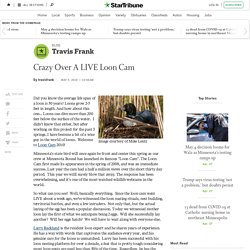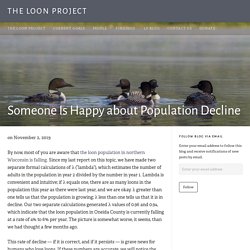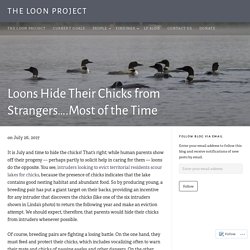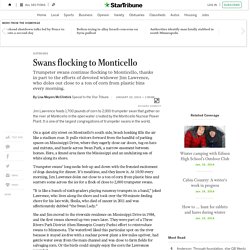

The Narrow Confines of Our Ideas – The Loon Project. Science is, by nature, cumulative.

Theories put forward centuries, decades, or years ago form the foundation of ideas we test today. If those theories fail to explain patterns we see in nature, they are refined or discarded and replaced by new theories that themselves must be tested ceaselessly and revised or rejected. Tom Rosenbauer. Startribune. Image courtesy of Mike Lentz Did you know the average life span of a loon is 30 years?

Loons grow 2-3 feet in length. And how about this one... Loons can dive more than 200 feet below the surface of the water. I didn't know that either, but after working on this project for the past 3 springs, I have become a bit of a wise guy in the world of loons. Minnesota's state bird will once again be front and center this spring as our crew at Minnesota Bound has launched its famous "Loon Cam". So what can you see? Larry Backlund is the resident loon expert and he shares years of experience. This year the Loon Cam will run from April through June. Watch the LIVE Loon Cam Image courtesy of Mike Lentz Did you know the average life span of a loon is 30 years?
Minnesota's state bird will once again be front and center this spring as our crew at Minnesota Bound has launched its famous "Loon Cam". So what can you see? Someone Is Happy about Population Decline – The Loon Project. By now, most of you are aware that the loon population in northern Wisconsin is falling.

Since my last report on this topic, we have made two separate formal calculations of λ (“lambda”), which estimates the number of adults in the population in year 2 divided by the number in year 1. Lambda is convenient and intuitive; if λ equals one, there are as many loons in the population this year as there were last year, and we are okay. λ greater than one tells us that the population is growing; λ less than one tells us that it is in decline. Our two separate calculations generated λ values of 0.96 and 0.94, which indicate that the loon population in Oneida County is currently falling at a rate of 4% to 6% per year.
The picture is somewhat worse, it seems, than we had thought a few months ago. This rate of decline — if it is correct, and if it persists — is grave news for humans who love loons. News – The Loon Project. “Bring me the broomstick of the Wicked Witch of the West”, the Wizard of Oz booms.

It is an iconic phrase in one of the most-watched movies of all time. The phrase is also both poignant and baffling. Of course, Dorothy and her companions are crestfallen to hear this “very small task” the Wizard has in mind for them. “If we do that”, the Tin Man stammers, “we would have to kill her.” It is impossible not to side with Dorothy and the Tin Man here. So it seems also with proposals to the National Science Foundation. Like the broomstick challenge faced by Dorothy and her companions, an NSF proposal is a formidable undertaking. Proposal-writing, moreover, is not like doing scientific work. Loons Hide Their Chicks from Strangers….Most of the Time – The Loon Project. It is July and time to hide the chicks!

That’s right; while human parents show off their progeny — perhaps partly to solicit help in caring for them — loons do the opposite. You see, intruders looking to evict territorial residents scour lakes for chicks, because the presence of chicks indicates that the lake contains good nesting habitat and abundant food. So by producing young, a breeding pair has put a giant target on their backs, providing an incentive for any intruder that discovers the chicks (like one of the six intruders shown in Linda’s photo) to return the following year and make an eviction attempt. We should expect, therefore, that parents would hide their chicks from intruders whenever possible. Of course, breeding pairs are fighting a losing battle. Although chick-hiding is a tricky business, loon families do have a strategy for coping with the sudden appearance of intruders overhead, which fly over at a speed of about 70 miles per hour.
The Day the Dinosaurs Died. If, on a certain evening about sixty-six million years ago, you had stood somewhere in North America and looked up at the sky, you would have soon made out what appeared to be a star. If you watched for an hour or two, the star would have seemed to grow in brightness, although it barely moved. That’s because it was not a star but an asteroid, and it was headed directly for Earth at about forty-five thousand miles an hour. Supermoon Lunar Eclipse To Become The First Pan-American Total Eclipse In 19 Years.
The Supermoon lunar eclipse of 2015 was the first such combination since 1982, and was the largest diameter Moon to be seen in lunar eclipse in more than three decades. 2018 had one, and so will 2019 on January 20/21.Jimmy Baikovicius from Uruguay When the Sun, Earth, and Moon line up just properly, the shadow cast by our planet can fall onto the Moon.

If the alignment is perfect, the result will be a total lunar eclipse, where the entirety of the Moon enters the darkest part of Earth's shadow. During this time, anyplace on Earth's surface that experiences night will be treated to the spectacular show of a completely red, dim Moon. Total lunar eclipses are relatively common; we get about one per year, on average.
Swans flocking to Monticello. On a quiet city street on Monticello’s south side, brash honking fills the air like a stadium roar.

It pulls visitors forward from the handful of parking spaces on Mississippi Drive, where they eagerly close car doors, tug on hats and mittens, and hustle across Swan Park, a narrow easement between homes. Here, a fenced area faces the Mississippi and an undulating sea of white along its shore. Trumpeter swans’ long necks bob up and down with the frenzied excitement of dogs dancing for dinner. It’s mealtime, and they know it. At 10:30 every morning, Jim Lawrence doles out close to a ton of corn from plastic bins and scatters some across the ice for a flock of close to 2,000 trumpeter swans.